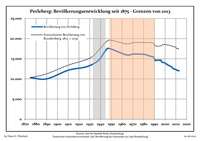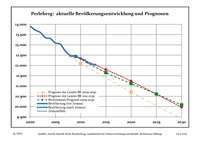Perleberg
| Perleberg | ||
|---|---|---|
|
Town hall and St. James's church | ||
| ||
 Perleberg | ||
Location of Perleberg within Prignitz district  | ||
| Coordinates: 53°04′00″N 11°52′00″E / 53.06667°N 11.86667°ECoordinates: 53°04′00″N 11°52′00″E / 53.06667°N 11.86667°E | ||
| Country | Germany | |
| State | Brandenburg | |
| District | Prignitz | |
| Government | ||
| • Mayor | Annett Jura (Ind.) | |
| Area | ||
| • Total | 137.82 km2 (53.21 sq mi) | |
| Population (2015-12-31)[1] | ||
| • Total | 12,204 | |
| • Density | 89/km2 (230/sq mi) | |
| Time zone | CET/CEST (UTC+1/+2) | |
| Postal codes | 19348 | |
| Dialling codes | 03876 | |
| Vehicle registration | PR | |
| Website | www.stadt-perleberg.de | |
Perleberg is the capital of the district of Prignitz, located in the northwest of the German state of Brandenburg. The town received city rights in 1239[2] and today has about 12,000 inhabitants. Located in a mostly agricultural area, the town has a long history of troops being stationed here (most notably Prussian) and as an administrative center for local government.
Geography
Perleberg is located in the heart of the district of Prignitz, about halfway between the two largest German cities Berlin and Hamburg.[3] It is surrounded by the municipalities Karstädt in the north-west, Groß Pankow (Prignitz) in the north-east, Plattenburg in the south-east; the Ämter Bad Wilsnack/Weisen in the south, Lenzen-Elbtalaue in the west; the town Wittenberge in the south-west.
The Stepenitz flows from northeast to southwest through Perleberg. The town's historic center is build on an island between two arms of the river.
History
One of the city's oldest buildings is St James's church. First mentioned in 1294,[4] it was frequently altered and extensively remodelled in the 1850s.[5] In German, it is called the Jakobikirche, and therefore sometimes mistakenly called St Jacob's in English.
In the 14th century the town was on its height as part of the Hanseatic League. In 1523 it was the muster-point for an army assembled by Elector Joachim I in support of his brother-in-law Christian II of Denmark's attempt to recover his throne. The Thirty Years' War caused serious damage to the town: of 3,500 inhabitants, only 300 survived.[2] The mayor responsible for rebuilding the city after this period was Georg Krusemarck.
On November 25, 1809, Lord Benjamin Bathurst disappeared in Perleberg. Later accounts of the incident exaggerated the circumstances to such an extent that the disappearance is sometimes claimed to have been caused by paranormal phenomena.[6]
Demography
 Development of Population since 1875 within the Current Boundaries (Blue Line: Population; Dotted Line: Comparison to Population Development of Brandenburg state; Grey Background: Time of Nazi rule; Red Background: Time of Communist rule)
Development of Population since 1875 within the Current Boundaries (Blue Line: Population; Dotted Line: Comparison to Population Development of Brandenburg state; Grey Background: Time of Nazi rule; Red Background: Time of Communist rule) Recent Population Development (Blue Line) and Forecasts
Recent Population Development (Blue Line) and Forecasts
|
|
|
|
People
- Ernst Ehrenbaum, born here
- Lotte Lehmann, born here
- Dörte von Westernhagen, born here
References
- ↑ "Bevölkerung im Land Brandenburg nach amtsfreien Gemeinden, Ämtern und Gemeinden 31. Dezember 2015 (Fortgeschriebene amtliche Einwohnerzahlen auf Grundlage des Zensus 2011)". Amt für Statistik Berlin-Brandenburg (in German). 2016.
- 1 2 "Geschichte". Official website of Perleberg (in German). Stadt Perleberg. Retrieved 18 July 2011.
- ↑ "Liebenswerte Stadt im Herzen der Prignitz". Official website of Perleberg (in German). Stadt Perleberg. Retrieved 8 April 2011.
- ↑ Höpfner, August. "Die St. Jacobykirche". Perleberger Reimchronik (in German). Retrieved 18 July 2011.
- ↑ "St. Jacobi Kirche". kirchenkreis-prignitz.de (in German). Evangelischer Kirchenkreis Perleberg-Wittenberge. Retrieved 18 July 2011.
- ↑ Dash, Mike (1990). "The Disappearance of Benjamin Bathurst" (PDF). Fortean Times (54). pp. 40–44.
- ↑ Detailed data sources are to be found in the Wikimedia Commons.Population Projection Brandenburg at Wikimedia Commons
External links
![]() Media related to Perleberg at Wikimedia Commons
Media related to Perleberg at Wikimedia Commons
